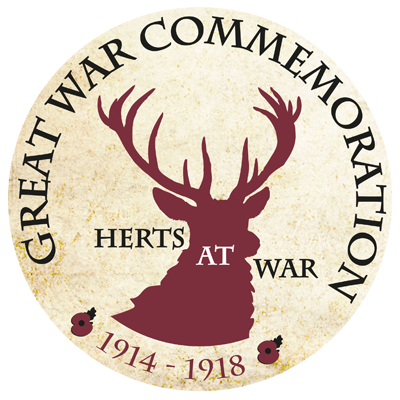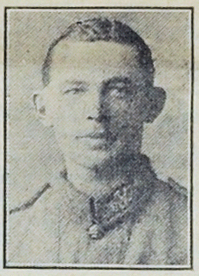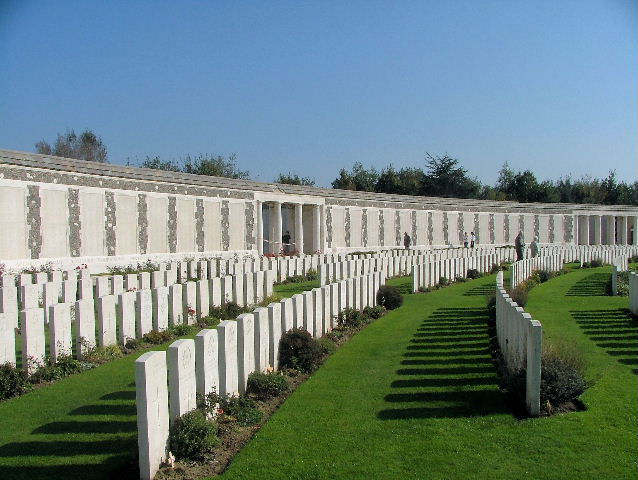Name
Jack Welch (MM)
1896
Conflict
First World War
Date of Death / Age
26/09/1917
21
Rank, Service Number & Service Details
Corporal
265532
Hertfordshire Regiment
Awards: Service Medals/Honour Awards
1914 (Mons) Star, British War and Victory Medals
Military Medal
Cemetery/Memorial: Name/Reference/Country
TYNE COT MEMORIAL
Panel 153.
Belgium
Headstone Inscription
NA
UK & Other Memorials
Hitchin Town Memorial, 4 Co' Hertfordshire Reg' Territorials’ Memorial, Hitchin, Town Hall Memorial, Hitchin, St Mary's Church Roll of Honour (Book), Hitchin, Hertfordshire Regimental Memorial, All Saints Church, Hertford
Pre War
Jack was born in 1896 in Hitchin and christened on 11th March 1886 in St. Mary’s Church, Hitchin, Herts. His parents were Frederick and Hannah Welch (née Dear), who married in the same church on 25th December 1890.
In 1901 the family were living at 16 St. Andrews Street, Hitchin. Present were both parents: Frederick (32) and Hannah (30), with Frederick working as a navvy on the Great Northern Railway. Their children were: Rose (10), Elizabeth (7), Jack (5) and Alice at just 4 months.
In 1911 the family were still living at 16 St. Andrews Street. Present were both parents, Frederick now working as a bricklayer’s labourer. The census recorded they had been married for 20 years with 9 children, of whom 3 had died. Of the above only Alice was not recorded. Jack was now 16 and working as a stable boy. New siblings were Fred (8), Charley (4) and George (2).
Jack enlisted into the 1st Battalion, Hertfordshire Regiment, Territorial Force on 23rd May 1913 as Private 2209. At that time he was 18 years and 3 months old and working as a wood machinist at Woodworkers Ltd of Letchworth. He was living at home with his family, with the address now recorded as Hill View, St. Andrews Street, Hitchin. He was described as 5’ 7 1/2” tall, and had a 36” chest when fully expanded.
His service record shows that he was discharged on 8th August 1914 and described as “being Medically Unfit for further Military Service”. It is not clear how he managed to get round this and serve, yet he has another service record. This shows that he re-enlisted into the 1st Battalion, Hertfordshire Regiment on 5th September 1914 as Private 2587. At this time he was described as 19 years and six months old, 5’ 8” tall, with a dark complexion, brown eyes and dark hair, he had a 36” chest when fully expanded.
Wartime Service
Jack’s complicated enlistment is described above, and his second period of service started immediately upon his re-enlistment on 5th September 1914. Territorials were not required to served overseas but could volunteer to do so, which Jack did on 8th September 1914.
He then went to France with the rest of his Battalion, landing there on 5th November 1914. So they must have been aware of his previous Territorial experience and training, because if his first period of service had not been recognised, he would not have gone to France so early in the war.
His notebook and service records give some indication of his Army service and that of the Hertfordshire Regiment. Having arrived in France the Hertfordshire Regiment was made part of the 4th (Guards) Brigade in the 2nd Division on the 20th November 1914. Such was their service alongside the ‘Guards’ that they became known as the ‘Herts Guards’ and they served around Ypres in Belgium. It is believed that Jack served as a stretcher-bearer.
He went on leave on the 10th December 1915, no doubt having been engaged in helping the many casualties from the violent fighting of that year. In February 1916 the Hertfordshires were transferred to the 118th Brigade of the 39th Division which was part of III Corps in the 1st Army. Jack was promoted to Lance Corporal ‘In the Field’ on 1st March 1916, but this may have been a temporary appointment.
April 24th, 1916, found him at Festubert, then a second period of leave commenced on the 3rd May 1916. Although this seems to be contradicted by his service record which records him as to be made Acting Lance Corporal ‘vice’ to 3398 Higgins - perhaps this was decided in his absence. Shortly after his return, on the 18th May, the Hertfordshires were at Givinchy (Givenchy). A succession of moves followed. Souchez on June 12th, 1916, Rue de Vintage (Riez-du-Vinage), on the 24th July, Locon on the 29th June, Hingette (Hinges) on the 10th July, Festubert 26th July and Bethune on the 4th August. All punctuated with spells in the front line but no major actions.
On the 25th July 1916 his appointment to Lance Corporal had been confirmed. On the 20th August he arrived at Guesterville (Guestreville) in the Somme District and on the 28th August he went by bus to Mailly Maillet arriving on the 2nd September. He noted being at Ingelbalmere (Engelbelmer) on the 9th September and at Knightsbridge on the 25th September 1916. The 12th October found him at Martinsaake (Martinsart) and on the 24th October he arrived at Lenlis (Senlis-le-Sec).
On November 1st, 1916, he was appointed Acting Corporal as ‘vice’ to 3200 Richards and was awarded the Military Medal for an act of bravery, possibly connected to his stretcher bearing. He was then confirmed as Corporal on the 5th, and later in November 1916 he wrote home to say that the award had been made.
The Battalion war diary for 3rd November 1916 reads: “The Bn was relieved by the 17th Notts & Derby Regt. & marched to huts in PIONEER ROAD. A draft of 6 OR joined the Bn from Base. Divisional Routine Orders announced that Captain C.F. Hacker (MC, RAMC] and 2/Lieut. J.P. Kemble [MC] had been awarded the Military Cross and that 2745 Pte Ilott R. [MM], 2855 L/Cpl Sunders E.T. [MM], 2587 L/Cpl Welch [Jack WELCH, MM] had been awarded the Military Medal, all of them for conspicuous gallantry and good work on Oct. 14th.”
The entry for October 14th reads: “Captain E. Lee was killed in action in the morning. In the afternoon the Cambridgeshires and Black Watch attacked and took the remainder of the SCHWABEN REDOUBT. The Bn sent one platoon to reinforce but was not otherwise involved, except being heavily shelled.” – this was the period of the Battles of the Somme 1916 and specifically the Battle of the Ancre Heights."
By the 12th November 1916 he was in Thiepval, and ready for the Battle of the Ancre which commenced the next day. The advance began on the 13th November with No. 4 Company on the extreme right of the 118th Brigade. No. 4 Company worked steadily forward up the Hansa Line killing and wounding many of the enemy in the process. He arrived in Beaumont Hamel that day and on the night of the 14th/15th November the Battalion was relieved after relatively few casualties by the standards of those days. Out of the Battalion of approximately 800 fighting men they had lost 7 officers and 150 other ranks. The survivors marched to a hutted camp near Aveluy where they arrived on the 16th November having given a very good account of themselves as part of a well-organised plan.
On the 18th November 1916 they retired to Doullens, on to Caudas on the 21st November and to Wormout (Wormhout) on the 28th November, arriving at Ypres on the 23rd December. They stayed in Ypres for the first three months of 1917 and were in and out of the front line, both engaging in and repelling trench raids. The early part of 1917 is when Jack would have been renumbered to 265532 - soldiers who had enlisted in, or were serving in, a Territorial Force regiment were issued with a new, six-digit service number. This was largely related to the huge increase in the numbers of men serving in the infantry regiments and the need to avoid confusion.
April 22nd found him in Vandhouke (? Brandhoek) and at the Boulounge (Boulogne) Rest Camp on the 3rd June 1917. Later in the month he attended the 2nd Army School of Musketry, and he was resting on the 1st and 25th July. On the 27th July he was at the YRB Canal and at Ypres on the 30th July 1917.
The Hertfordshires were involved in their most devastating action from all points of view on the 31st July and 1st August 1917 in the Battle of St. Julien. The 1st Hertfordshire Battalion were in support of an attack on the Langemarck Line and a general bombardment of the German lines commenced at 3.45am on the 31st and the planned assault began. It had three objectives to achieve known as Blue, Black & Green and units of the 116th Brigade easily captured the first two objectives, preparing the way for the forward companies of the Hertfordshire battalion, to take the third objective.
They had marched from Vlamertingue to their assembly position arriving by midnight on the 30th/31st July 1917. A general bombardment of the German lines commenced at 3.45am on the 31st July. At 05.00am the Hertfordshires left their assembly positions to attack their objective, which lay over the crest of a ridge.
As they made their way forward, they came under heavy fire from both German machine guns and snipers but after eliminating a German strongpoint moved up towards St. Julien, which was only lightly held. The Battalion crossed the Steenbeek with some difficulty and two of its supporting Tanks became bogged down in the mud. Things then went from bad to worse. A pre-arranged artillery barrage never materialised due to the guns being unable to move forward over the muddy terrain and the German barbed wire defences, which were fifteen feet deep in some places, were found to still be intact. It was soon realised that ground could only be won by section "rushes" supported by the unit’s own fire.
The Cheshire Regiment were on the right of the battalion but the Black Watch, who were due to cover the left flank, had been seriously delayed. This left the Hertfordshire Regiment seriously exposed, the Germans exploited this by bringing a hurricane of fire down upon the stricken troops. This was followed by a German counterattack and by 10.30am it was clear that the objective could not be achieved. Casualties were very heavy with 459 men being killed, missing or wounded. This was 100% of its Officers and about 75% of its Other Ranks and the Hertfordshires temporarily ceased to exist as a fighting unit.
One of the casualties was Jack, he was taken to 62 Casualty Clearing Station on the 31st, admitted to 132 Field Ambulance on August 4th, though he does not seem to have been seriously injured as he was returned to duty on August 5th and re-joined his unit on the 9th. In fact later notes clarified the injury as ‘Classified Shell Shock (Wd)’ {Wound}. He was given his last leave on the 19th August 1917.
There is a slight discrepancy in the records concerning the date of his death. Family records show it as the 24th September 1917 but the Commonwealth War Graves Commission and the ‘Soldiers died’ database shows it as the 26th September 1917. The Herts were not engaged in any major action on either date, but they were in the lines at ‘Shrewsbury Forest’. There was often a steady attrition whenever units took their place in the line, quite apart from the constant shelling and sniping which went on round the clock in most of the forward areas, getting to and from the front lines was dangerous. His notebook records the names of several men who were previously killed or wounded. In respect of Jack, a comrade wrote home and said that everything possible was done for him, but his wounds proved fatal. This suggests that he died of wounds in a forward area as his body was not found at the end of the war.
He has no known grave but is remembered on the Tyne Cot Memorial to the Missing at Passchendaele in Belgium.
In 1918, Colonel J.A. Rose, Officer Commanding the Hitchin Signal Depot, Royal Engineers, presented the Military Medal to Jack's mother.
Additional Information
After his death £9 15s 4d pay owing was authorised to go to his mother, Hannah, on 11th February 1918. Later, a war gratuity of £14 10s was authorised to be paid to her on 5th November 1919.
His father submitted a statement of the names and addresses of all his living relatives on 26 August 1918 (year uncertain, but probably 1918). It confirmed the names of Jack's parents as Frederick and Hannah Welsh living at 1 Hill View, St. Andrews Street, Hitchin, Herts., and his brothers as Frederick (16), Charles (11), George(9). and sisters Rose (28) and Elizabeth (25). All still living at 1 Hill View – ages all as recorded on the form.
His pension cards record Mrs Hannah Welch as his mother and dependant, living at 1 Hill View, St Andrews Street, Hitchin. She was awarded a pension of 6s a week from 16 April 1918. Later this was changed to his father Frederick and was after Hannah had died.
His mother probably received his personal property in 1918 and received his British War and Victory medals on 14 April 1921. She would also have received a memorial plaque and scroll.
Acknowledgments
Adrian Dunne, David C Baines, Jonty Wild



